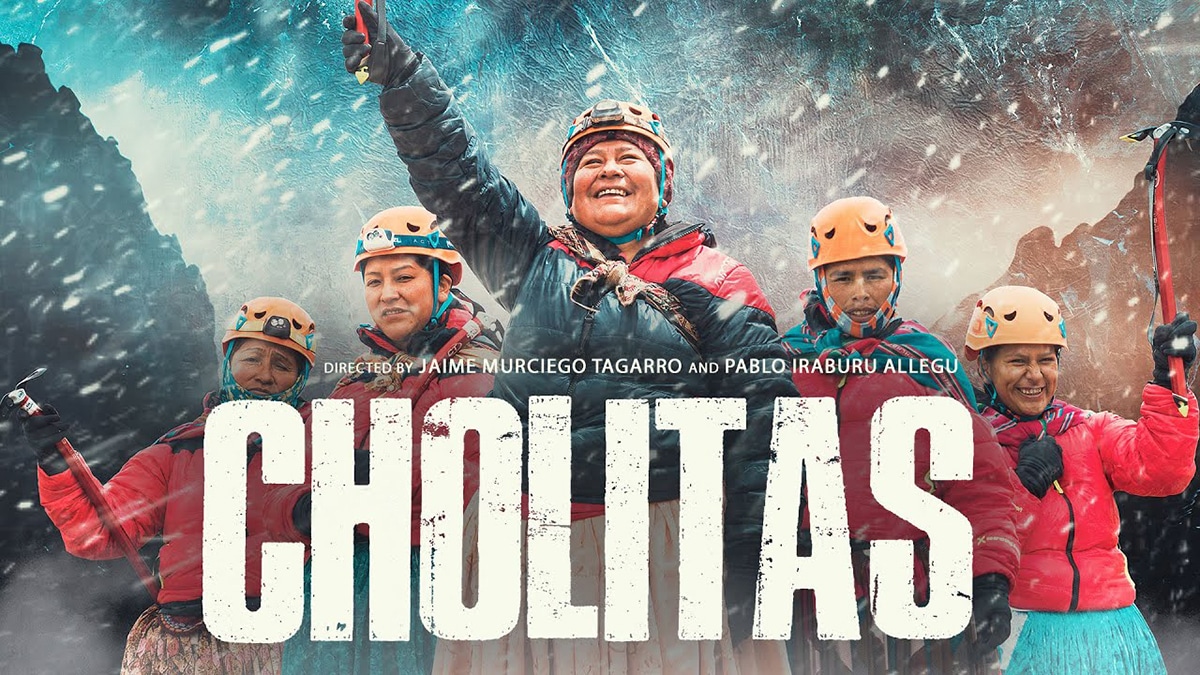Appreciating the mountain and respecting Pachamama make the expedition a greater triumph. Meaning: focusing on enjoying the journey is one of the greatest lessons you can get from the documentary Cholitas (aka Indigenous, Bolivian women).
Dora Magueño, Cecilia Llusco, Ana Lía (Liita) González, Lidia Huayllas, and Elena Quispe begin their journey in El Alto and La Paz, Bolivia, at 4150 meters above sea level (MASL). After climbing some peaks such as Huayna Potosí (6088 MASL), Sajana (6542 MASL), and Illimani (6,462 MASL), the five Indigenous women venture to Aconcagua in Argentina, which has the highest peak in the American continent at 6965 MASL.
Cholitas is a powerful visual directed by Jaime Murciego Tagarro and Pablo Iraburu Allegue, and it tells a story of self-determination, strength, and liberation. These five Aymara (native Indigenous people of South America) are the voices of an entire community, representing women who have been silenced over the years by cultural traditions and political forces.
“My husband used to tell me ‘stand up,’ I would stand up, ‘sit down,’ I would sit down,” Lidia shares in the documentary. Climbing changed her, though, and now she can say no. “I’m going to be what I want. Now I feel free to be able to express what I want.”
Their husbands are mountain guides on tourist expeditions in the Andes and support them on their trek, although it’s certainly more traditional for them to stay home. Now these cholitas share a passion for mountaineering that drives them to fulfill dreams that once seemed impossible, such as submitting Aconcagua.
They are examples of strength, tolerance to pain, feminine resistance, and their culture. The cholitas defend their Indigenous identity through typical dress — climbing imposing mountains in colorful skirts. Rituals are part of their identity too. Before ascending, the five cholitas together with Paula Celso and Emilio Nicolás Agüero, official guides of Aconcagua Park, ask permission from Pachamama to proceed, paying her tribute with coca leaves and alcohol. They do not know if the mountain will allow them to climb, the weather is demanding and hostile. But they ask for her blessing, anticipating the views if they can get above the clouds.
No one guarantees the conquest of Aconcagua. The acclimatization of the body, the altitude, and the climate all play an important role. The summit is personal and everyone reaches the place the right point as their destination. After arriving with laughter at more than 4,000 MASL, the cholitas are welcomed to the Plaza de Mulas base camp with snowflakes, a beautiful scene that brings them to tears. But later, weather conditions, including winds of 59 miles per hour at the summit, delay their ascent.
The group’s strength helps them almost touch the sky, but the difficulties increase. The cholitas know they must adapt to what nature dictates. Lidia stops because she does not want to obstruct her teammates. It is difficult for her to turn back, but it’s the safest thing to do. Dora returns with Lidia, she can’t go on either. Still, they know they have not failed – they take with them the experience of climbing to more than 6000 MASL, meeting new people, and going to new places. Later, Cecilia also decides to return, her body is not adjusting. “That’s how the mountain is, it receives you well, sometimes it rejects you,” she says when she turns back. But Elena and Liita make it for everyone, summiting one of the most challenging places.
Later, Liita teaches her students at school about the value of dreams, focusing on their shared Indigenous communities: “There’s still a lot to work on, but it’s a good start.” Meanwhile, Elena believes that the mountain makes change. In the documentary, she talks about how she remains the same with a different mentality. She is not the only one – these women now believe in themselves. “More mountains await me. To go to Everest. That’s my dream. The fear is gone, I have left in Aconcagua the fear,” says Elena. And they are not just words, she is preparing. Las Cholitas Escaladoras recently posted on Instagram that she and some new climbers are enrolled in an Everest expedition.
“My mom always said, you have to know how to live life, otherwise life will live you,” says Lidia in the documentary. And that’s what she does at over 50 years old, climbing these mountains and modeling the typical cholita dresses that she loves and wears confidently, even on the Bolivian runways. Lidia and the rest of the cholitas are a great inspiration, and the documentary reflects their strength with beauty, nourishing the soul through tears of joy for the goals they achieve.

Cholitas is now available to screen on Roku, Tubi, and Kanopy.

